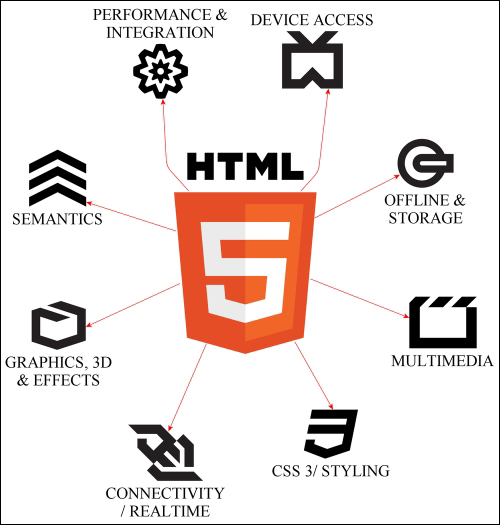Java EE 7 is about features that offer the developers enhanced HTML5 support. HTML stands for HyperText Markup Language and is designed as a structure for presenting and structuring content for the World Wide Web (WWW). Sir Tim Berners-Lee invented HTML and the first web browser in 1990. At the time of writing, the fifth revision of HTML is expected to be announced as an official standard by the end of 2014. HTML5 improves support for latest multimedia. The fruits of its labor have been deliberated upon since the Web Hypertext Applications Technology Group (WHATWG) (http://whatwg.org/html) meetings from 2004. HTML5 is an official standard of the World-Wide Web Consortium (W3C) (http://www.w3c.org/TR/html5), which is built on the joint venture work of the WHATWG and the W3C.
HTML5 now embraces new media types, which are one of the great highlights of it, namely video, audio, and canvas. The canvas is a special type of drawable apparatus in the web browser, where the web client developers can manipulate dynamic content with the JavaScript programs.
There is a series of new tag elements to give a better structure to HTML5 documents. New web applications are encouraged to write or generate HTML5 content with article, section, header, footer, figure, figcaption, hgroup, nav, summary, and detail, time, or aside tags. This is just a small sample of the new semantic and document structure of HTML5 tags. There are several tag elements, such as center, which are deprecated, because these features are better expressed with Cascading Style Sheets (CSS) rather than markup.
HTML5 is also an aggregation term that stands for the set of emerging multimedia technologies that are supported by the markup language. Browser support CSS 3 is regularly expected for HTML5 compatibility. Moreover, our industry is presently undergoing a mobile web application revolution on smartphones and, especially, tablet computing devices. HTML5 not surprisingly also adds the geolocation support, including the location tracking in the browser. It also covers offline session and local storage for web applications that run on mobile devices, such as smartphones or tablets. These applications can save state when the connection to the Internet is lost.

Some of the modern HTML5 supporting browsers actually have the 3D graphics support through a working standard called WebGL , which impacts the amount of data that is streamed from the server to the client. 3D graphics and high-resolution media generally entails a larger server-side push of data compared to lesser media websites. There is a sliding scale of capability with the current versions of Firefox, Safari, Chrome, and Opera browsers. The outlier is typically Microsoft's web browsers Internet Explorer 9 and 10. For those of you who want 3D effects without the reliance of WebGL you should take a look at the CSS 3 3D transformations.
Finally, JavaScript is a single thread in the execution in a web browser. There is no way to spawn multiple threads in modern standard W3C conforming web clients. HTML5 also embraces two fundamental groundbreaking changes: Web Works and WebSocket. Web Works is a JavaScript compatible API that allows web clients to run long-running code that does not block the browser. WebSocket is a new way for a browser and server to exchange an asynchronous communication without having to constantly send the metadata information. WebSocket is an extension of the TCP/IP Socket protocol specifically for HTTP communications.
